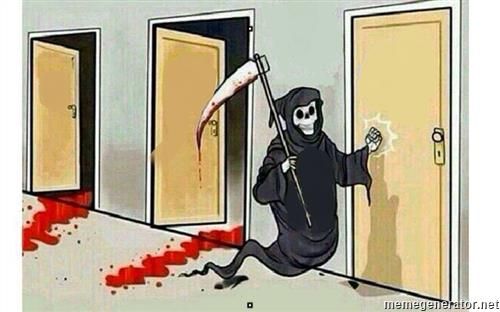
Spongebob Rainbow
The "Spongebob Rainbow" meme features SpongeBob SquarePants with a vibrant rainbow and sparkling stars arching above his head. This iconic image originates from the 2002 SpongeBob SquarePants episode "Idiot Box." In the scene, SpongeBob uses his hands to demonstrate "imagination," producing the whimsical visual effect. The meme is predominantly used to sarcastically highlight an obvious or simplistic concept as if it were a profound or groundbreaking revelation. It conveys an exaggerated sense of importance or mock enlightenment, often with a touch of whimsical absurdity, making it a popular choice for humorous and ironic commentary.

Disappearing Kid Gif
The "Disappearing Kid Gif," also known as the "Lil TerRio Disappearing Gif," originates from a 2014 Vine video featuring then-young rapper and internet personality Lil TerRio. In the original clip, TerRio is seen dancing and then slowly fading out of the frame. This meme typically features two panels: the top showing a person, often Lil TerRio, looking with a slightly displeased or dismissive expression, and the bottom panel showing them partially or entirely faded, as if they are disappearing. The GIF is primarily used as a humorous reaction to convey a desire to quickly exit or avoid an awkward, uncomfortable, or undesirable situation. It signifies a silent "I'm out," "Nope," or a wish to become invisible to escape responsibility or an unpleasant conversation. Its usage highlights a relatable feeling of wanting to vanish from a situation.

Obama Medal
The "Obama Medal" meme features a photoshopped image of former U.S. President Barack Obama appearing to award himself a medal. The original picture, taken in 2017, shows Obama presenting the Presidential Medal of Freedom to then-Vice President Joe Biden. The meme's humor stems from the visual alteration, where Biden is replaced by another Obama, giving the impression of self-congratulation. It is widely used to humorously depict situations of self-praise, acknowledging one's own efforts, or taking credit for one's actions, often in a slightly ironic or exaggerated manner. It's applied when someone is overly pleased with their own accomplishments, no matter how trivial, or when highlighting a moment of personal triumph or reward.

Grim Reaper Knocking Door
The "Grim Reaper Knocking Door" meme features a cartoonish depiction of the Grim Reaper, the personification of death, knocking on the third of three doors. The first two doors are ajar, with blood trails leading from them, suggesting previous, perhaps less severe, but still negative, outcomes. The meme's origin is unclear but it gained popularity as a versatile template to represent an inevitable and often unwelcome consequence. It is typically used to illustrate a progression of events or choices leading to an ultimate, often dire, conclusion. Each door can be labeled with a different action, event, or decision, with the Reaper's knock signifying the final, unavoidable reckoning.

Both Buttons Pressed
The "Both Buttons Pressed" meme originates from the webcomic "Petirep" by Petirep and Jake Clark. It typically features a character presented with two large red buttons, each representing a distinct, often conflicting, option or dilemma. Instead of choosing one, the character presses both simultaneously with a satisfied expression and a thumbs-up. The meme's meaning revolves around rejecting a forced choice and instead opting to combine or achieve both possibilities, usually for humorous or advantageous outcomes. It’s widely used to illustrate situations where one cleverly bypasses a dilemma, expresses a desire for "having it all," or simply refuses to compromise between two desirable yet seemingly exclusive options.

The Office Congratulations
The "Congratulations" meme featuring Steve Carell as Michael Scott originates from the popular US sitcom *The Office*, specifically Season 2, Episode 3, "Office Olympics." In the scene, a scruffy-looking Michael, complete with a mullet and fanny pack, awkwardly shakes hands with a representative from Lackawanna Leather. The meme is typically used ironically to offer "congratulations" for trivial, undesirable, or unimpressive accomplishments. It captures a sense of forced politeness, mild disappointment, or sarcastic acknowledgment, often highlighting an uncomfortable or underwhelming situation.

Drake Blank
The "Drake Blank" meme features two panels of Canadian rapper Drake. The top panel shows him recoiling with a disapproving expression, while the bottom panel depicts him smiling and pointing with approval. Originating from screenshots of his 2015 "Hotline Bling" music video, the meme gained massive popularity in 2016. It's used to express a clear preference or comparison between two contrasting options, where the top image represents something rejected or disliked, and the bottom image represents something chosen or favored. This versatile template is widely used across social media to illustrate humorous dilemmas, personal choices, or opinions.

Bugs Bunny Communist
The "Bugs Bunny Communist" meme features the iconic Looney Tunes character Bugs Bunny superimposed with the Soviet Union's hammer and sickle emblem. Originating from online communities, this meme humorously transforms Bugs Bunny, a symbol of American pop culture, into a proponent of communal ownership. Its meaning revolves around the satirical idea of shared possession or experience, often shifting a concept from "mine" to "ours." Users deploy this meme to comically assert collective ownership over items, situations, or ideas, playing on the stereotype of communist ideology in a lighthearted, often sarcastic, context. It's frequently used when something is taken or shared in a sudden or unexpected communal manner.

What Gives People Feelings Of Power
"What Gives People Feelings Of Power" is a popular meme template featuring a simple bar graph. Originating around 2019-2020 on platforms like Reddit, its source isn't attributed to a specific creator. The meme contrasts conventional sources of power like "Money" and "Status" (represented by shorter bars) with a significantly longer, often humorous, third bar. This longer bar is filled with an unconventional, specific, or even mundane action or situation that ironically provides an exaggerated feeling of power, satisfaction, or control. It's widely used to humorously highlight niche or relatable scenarios that give people a disproportionate sense of accomplishment, often subverting expectations in a comedic way.
